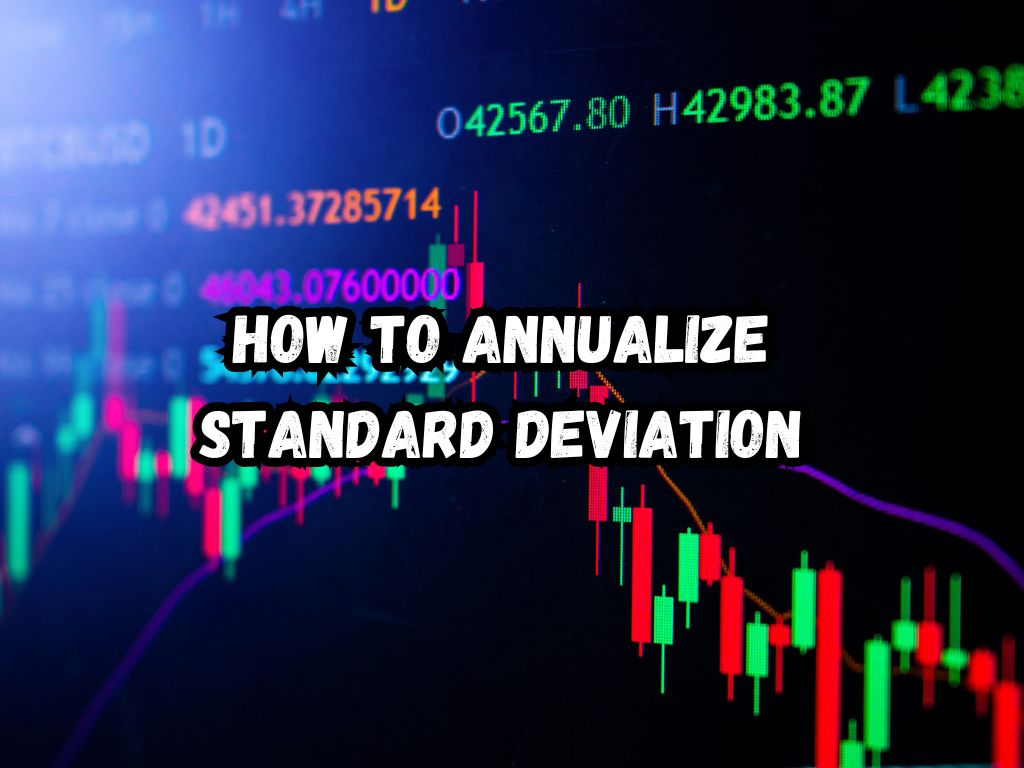When it comes to measuring volatility in financial markets, standard deviation is a term that is often bandied about.
But for investors and financial analysts, the raw standard deviation number isn’t always the most helpful. This is where the concept of annualizing standard deviation comes into play. It allows for a consistent comparison across different time periods to better understand investment risks.
This article offers a clear guide on how to annualize standard deviation, helping you make more informed decisions.
Understanding Standard Deviation in Finance
Volatility is the heartbeat of the market, representing the ups and downs of investment prices.
In this dynamic environment, standard deviation serves as a critical measure, quantifying how much an investment’s returns can vary from its average return. The essence of this concept lies in its ability to communicate risk—the higher the standard deviation, the greater the uncertainty and risk associated with the investment.
This metric becomes an integral part of portfolio management. By knowing the standard deviation, investors can gauge whether an investment aligns with their risk tolerance and how it might behave in various market conditions.
Using this knowledge, they can then construct a portfolio that aims to maximize returns while keeping risk levels in check.

The Need for Annualization
Inconsistency in timeframe comparisons can lead to misleading interpretations of risk. Annualizing the standard deviation of investment returns normalizes these figures, facilitating an apples-to-apples comparison.
This helps in comparing different investments or evaluating the performance of a single investment over various time spans.
For long-term investors or those involved in strategic planning, annualized figures are instrumental in crafting portfolios that stand the test of time.
How To Annualize Standard Deviation?
Gathering Data
To start, accumulate the necessary return figures of your investment. This could be daily, weekly, or monthly returns depending on available data.
Having all the relevant numbers at your disposal is paramount for accurate calculation.
Calculating Standard Deviation
With your data in hand, compute the standard deviation for the chosen time period. The mathematical formula for this initial calculation is critical. It takes the sum of the squared deviations of each data point from the mean, divided by the quantity of data points minus one.
This result is then square rooted to find the standard deviation, giving you the volatility measure for that period.
Annualizing the Calculation
To project this short-term standard deviation over a year, a scaling factor is used. If daily returns were your starting point, multiplying the standard deviation by the square root of 252—the typical number of trading days in a year—will do the trick.
For monthly returns, the square root of 12 becomes your multiplier. These factors stem from the financial market conventions and presume a consistent level of volatility throughout the year.
Interpreting the Results
Once annualized, standard deviation becomes a more digestible and comparable figure. High values point to more uncertainty and potential variability in returns, translating to greater risk.
Conversely, low values suggest a more stable investment, with expected returns hewing closer to the average. This knowledge can crucially influence investment strategy and decision-making.

Pro Tips
Accuracy can’t be overstated in this process. Start with precise data to avoid skewed results.
In our ever-advancing world, numerous software tools can aid with these computations, streamlining your analysis.
When it comes to understanding risk, juxtapose the annualized standard deviations of varied assets. This can illuminate the path to a well-diversified portfolio, spreading risk across uncorrelated investments.
Common Mistakes and How to Avoid Them
Errors in this calculation can significantly distort risk assessment. Always remember the impacts of compounding—overlooking this can lead to underestimating volatility.
Adjusting for the correct time period is another common trip-up. Ensure you use a consistent baseline for gathering data to sidestep discrepancies.
Lastly, maintaining a methodical approach to your analysis will prevent overlooking crucial steps.
Frequently Asked Questions
What is the difference between standard deviation and annualized standard deviation?
Standard deviation measures volatility over a specific time frame, while annualized standard deviation standardizes that volatility to a yearly scale, allowing for direct comparisons across periods.
Can annualized standard deviation predict future volatility?
Annualized standard deviation provides an estimate of past volatility, which may or may not be indicative of future variability, as market conditions can change unpredictably.
How does the length of the time period affect the annualization process?
The length of the time period determines the scaling factor used to annualize the standard deviation, with daily data typically multiplied by the square root of 252, and monthly by 12.
Why is it important to annualize standard deviation for portfolio analysis?
Annualizing standard deviation gives a consistent metric for assessing the risk of different investments over the same time frame, which is crucial for comparing performance and making informed decisions.
Is it possible to have a negative standard deviation when calculating on an annual basis?
No, standard deviation is a measure of dispersion around the mean and is always a non-negative value, regardless of the time basis.
Conclusion
Through annualizing standard deviation, investors and analysts can gain a more realistic understanding of an investment’s risk over a typical year.
This clarifies the level of uncertainty one might expect and better informs the decisions that shape financial health and success. Such a tool should take a prominent role in any investor’s risk management toolkit.


 Tags:
Tags:










